National symbols of Croatia
This articleneeds additional citations forverification.(April 2015) |
Thenational symbols of Croatiaare insignia, icons, or cultural expressions that are emblematic, representative, or otherwise characteristic of theRepublic of Croatia,Croatian people,or theCroatian culture.They are being implemented within the country and abroad as a form of representation for the nation's statehood or its unique cultural aspects.
Official Symbols
[edit]| Type | Image / Audio | Description |
|---|---|---|
| National flag | 
|
Flag of Croatia[1]
The flag of Croatia consists of three horizontal stripes of red, white, and blue, with the coat of arms in the centre. It is commonly known astrobojnica( "tricolour" inCroatian) and has been used in different forms since 1848. It combines the colours of historical flags of theKingdom of Croatia(red and white), theKingdom of Slavonia(blue and white), and partiallyKingdom of Dalmatia(blue and yellow). |
| Coat of arms | 
|
Coat of arms of Croatia[1]
The coat of arms of Croatia consists of one main shield and five smaller shields which are crowning it. The main coat of arms is acheckerboard(chequy) made up out of 13 red and 12 silver (white) fields. It is commonly known asšahovnica( "chessboard" in Croatian) orgrb(literally "coat of arms" ). The five smaller shields represent five historical regions of Croatia:Croatia proper,Dubrovnik,Dalmatia,Istria,andSlavonia. |
| National anthem | National anthem of Croatia[1]
"Lijepa naša domovino"(" Our Beautiful Homeland ") is the national anthem of Croatia. Its opening words,"Lijepa naša"(" Our Beautiful "), are widely used as ametonymfor the country. The original lyrics were written and published for the first time under the title "Horvatska domovina" ( "Croatian homeland" ) in 1835.[1] |
Unofficial Symbols
[edit]| Type | Image | Description |
|---|---|---|
| National icon | Croatian Glagolitic script
The Glagolitic script (Croatian:glagoljica) is the oldest knownSlavicalphabet.In Croatia, Glagolitic inscriptions appear in the 12th-century littoral areas such as Istria,Kvarner,or Dalmatia, but there are also findings fromLika,Slavonia, andNorthern Croatia.The 1483Missale Romanum Glagoliticewas the first Croatian printed book.[2]Angular Glagoliticletters ⰘⰓ (Latin:"HR"for"Hrvatska") are featured on the obverse side ofCroatian euro coins. | |

|
Croatian interlace
The Croatian interlace (Croatian:pleterortroplet) is a type ofinterlace,most characteristic for its three-ribbon pattern. It is one of the most often used patterns inearly medievalCroatian art,where ornamental strings are sometimes grouped together with animal and herbal figures. The symbol is still used in Croatia today as a symbol of Croatian culture.[3]Croatia also awards a civil and military decoration called theOrder of the Croatian Interlace.[4] | |

|
Croatian checkerboard
The Croatian checkerboard or chequy (Croatian:šahovnica) is the national symbol of Croatia and Croats.[5]As in the coat of arms, the red and white squares are arranged evenly, although the order has varied historically.Jerseysandhatsusing the pattern are widely used by Croatiansports teamsandfans.It can be found as a decoration on various touristsouvenirsas well. Croatian euro coins all feature the chequy on their obverse side.[6] |
| Type | Image | Description |
|---|---|---|
| Cultural symbol | Necktie
The contemporary necktie (Croatian:kravata) traces back its origins from thecravatworn byCroatian mercenarieswho served inFranceduring theThirty Years' War(1618-1648). These mercenaries from theMilitary Frontier,wearing their traditional small, knotted neckerchiefs, aroused the interest ofParisians[7]and soon the fashion spread among the French nobility of the time. The International Necktie Day is celebrated in Croatia on October 18 every year.[8] | |

|
Needle lace
The Croatian needle lace (Croatian:čipka) is a traditional cultural artefact that dates back to the times ofRenaissance.With the years, Croatian needle lace has become notable for its unique patterns and designs. In 2009,UNESCOrecognised the lacemaking in Croatia as anIntangible Cultural Heritage of Humanity.[9]Most notable centres of lacemaking in Croatia today areLepoglavainHrvatsko Zagorje,Sveta MarijainMeđimurje,and the island ofPag. | |

|
Licitar
Licitars (Croatian:licitar) are colourfully decoratedgingerbread biscuitsmade of sweet honey dough that are a part of Croatian cultural heritage. They are also a symbol of the capital city ofZagreband where they are being used as an ornamental gift, often given at celebrations such as weddings or theValentine's Day.In 2010, UNESCO recognised the gingerbread craft from Northern Croatia as an Intangible Cultural Heritage of Humanity.[10] | |
| National costume | 
|
Croatian national costume
The Croatian dress (Croatian:hrvatska narodna nošnja) refers to the traditional clothing worn by Croats. Each cultural and geographicalregion of Croatiahas its own specific variety of costume that varies in style, material, colour, shape, and form. Many of these regional costumes were influenced by theHungarian,Austrian,Italian,orOttomanpresence.[11]Today, the national costumes are most often worn at special events or celebrations. |
| National sport | 
|
Sinjska alka
The Sinjska alka is an equestrian competition that has been held in the Croatian town ofSinjon every first Sunday in August since 1715 and commemorates a Croatian–Venetian victory in theOttoman–Venetian war.[12]At the competition, horsemen riding at full gallop aim their lance at a hanging metal ring (alka), and are awarded points according to which sector of the ring they are able to pierce. In 2010, UNESCO recognised the alka as an Intangible Cultural Heritage of Humanity.[13] |
| National instrument | Tamburica
Tamburica is the national string instrument of Croatia. It derives its name and some characteristics from thePersiantanbur,but it also resembles themandolinandguitarin the sense that its strings arepluckedand often paired. The frets may be moveable to allow the playing of variousmodes.The variety of tamburica shapes known today were developed at the end of the 19th century, and the instrument is often associated with the region of Slavonia.[14] |
| Type | Image | Description |
|---|---|---|
| National landmark | 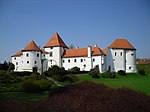
|
Varaždin Castle
The Varaždin Castle (Croatian:Stari grad Varaždin) is located inVaraždin,a city in Northern Croatia that became the national administrative centre for a brief period in the 18th century.[15]The castle is an example of medieval defensive architecture whose construction began in the 14th century, and in the following century the rounded towers, typical forGothic architecturein Croatia, were added. The Varaždin Castle and its layout were featured on the reverse side of the 5 kuna banknote.[16] |

|
Pula Arena
The Pula Arena (Croatian:Pulska Arena) is aRoman amphitheatrelocated inPula,a city in Istria, western Croatia. It is the only remaining Roman amphitheatre to have four side towers entirely preserved. It was constructed between the years 27 BC and 68 AD, and is among the world's six largest surviving Roman arenas.[17]The Pula Arena was featured on the reverse side of the 10 kuna banknote along with the layout of the town ofMotovun.[18] | |

|
Eltz Manor
The Eltz Manor (Croatian:Dvorac Eltz) is aBaroque-erapalace inVukovar,a city in the Slavonian subregion ofSyrmiain eastern Croatia. The manor suffered substantial damages and destruction in 1991 during theCroatian War of Independence,but it was completely restored to its pre-war appearance and today it houses the Vukovar City Museum.[19]The Eltz Manor was featured on the reverse side of the 20 kuna banknote along with theVučedol dovefigure.[20] | |

|
Dubrovnik Old Town
The Dubrovnik Old town (Croatian:Stari grad Dubrovnik) forms the medieval core of the city ofDubrovnikin Dalmatia, southern Croatia, which was added to the UNESCOWorld Heritage Sitelist in 1979.[21]Between the 14th and 19th centuries, it was the centre of the maritime Republic of Ragusa and became a cradle of theCroatian literature.The Dubrovnik Old Town was featured on the reverse side of the 50 kuna banknote along with theRector's Palace.[22] | |
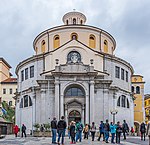
|
Rijeka Cathedral
The Rijeka Cathedral, also known as the St. Vitus Cathedral (Croatian:Katedrala Svetog Vida) is aRoman Catholiccathedral in the city ofRijeka,western Croatia. In the Middle Ages, the Church ofSt. Vituswas a small and one-sided,Romanesquechurch dedicated to the patron saint and protector of the city. The structure is arotunda,which is unusual for this part of Europe. The Rijeka Cathedral and its layout were featured on the reverse side of the 100 kuna banknote.[23] | |
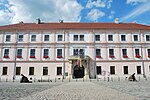
|
Palace of Slavonian General Command
The Palace of Slavonian General Command (Croatian:Palača Slavonske Generalkomande) is a building of the formerGeneralatefor theSlavonian Military Frontierlocated inOsijek,a city in Slavonia, eastern Croatia. Today it is a seat of theUniversity of Osijekrectorate and is one of the symbols of the city. The Palace of the Slavonian General Command was featured on the reverse side of the 200 kuna banknote along withTvrđa,the city's citadel where it stands.[24] | |
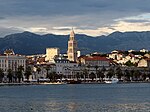
|
Diocletian's Palace
The Diocletian's Palace (Croatian:Dioklecijanova palača) is an ancient palace built for theRoman emperorDiocletianat the end of the third century AD,[25]and whose remains today form a central part of the city ofSplitin Dalmatia, southern Croatia. It was added to the UNESCO World Heritage Site list in 1979. The Diocletian's Palace was featured on the reverse side of the 500 kuna banknote along with the motif of a Croatian ruler from the 11th century.[26] | |

|
Zagreb Cathedral
The Zagreb Cathedral (Croatian:Zagrebačka katedrala) is a Roman Catholic cathedral located in Zagreb, the capital city in central Croatia. The cathedral has a distinctneo-Gothicappearance and is registered as a cultural good due to its architectural value.[27]Its prominent spires are considered to be landmarks as they are visible from most parts of the city. The Zagreb Cathedral was featured on the reverse side of the 1000 kuna banknote along with the statue ofKing Tomislav.[28] |
| Type | Image | Description |
|---|---|---|
| National drink | 
|
Croatian wine
The wine (Croatian:vino) has a long history in Croatia as it dates back to theAncient Greeksettlers and theirwine productionon the Dalmatian islands. Like otherold world wineproducers, many traditional grape varieties still survive in Croatia. Modern wine-production methods are common in larger wineries andEU-style wine regulations.[29]Some of the best known Croatian wine varieties areteran,graševina,plavac,dingač,andmalvazija. |
| National cuisine | 
|
Croatian cuisine
Croatian cuisine is known as the cuisine of regions due to its heterogeneity, since every region of Croatia has its own distinct culinary traditions.Continental partsof the country are defined by recipes from theSlavic cuisineas well as theHungarian,Austrian,andTurkishinfluences, while thecoastal partsare characterised by contancts with theItaliancuisine.[30]Some of the best known Croatian foods and dishes areštrukli,brudet,pašticada,orehnjača,andkulen. |
| Type | Image | Description |
|---|---|---|
| National personification | 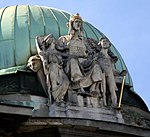
|
Mother Croatia
Mother Croatia (Croatian:Mati Hrvatska) is the female personification of Croatia. The nation has historically been portrayed as a motherland, and it is often personified through a female figure that evokes the traditional woman's role of a mother and a nurturer.[31]During theIllyrian movementof the 19th century, prominent writers and intellectuals used the figure of Mother Croatia to represent Croatian people in the context of nationhood and opposition to foreign authority.[32] |
| Type | Image | Description |
|---|---|---|
| National animal | 
|
European pine marten (Martes martes) The European pine marten (Croatian:kuna zlatica) is a species ofmustelidthat is a semi-official national animal of Croatia.[33]It has a symbolic meaning, since marten pelts (marturina) were collected as tax byearly Slavs,and because it appears prominently in theCroatian heraldry- this includes the national flag and the coat of arms, as well as historic and local emblems.[34][35][36]Banovaccoins also included a marten figure, and it is a namesake ofkuna,the former Croatian currency where it appeared on all obverse coin sides. The European pine marten is featured on the reverse side of the Croatian 1eurocoin.[37] |

|
Atlantic bluefin tuna (Thunnus thynnus) The Atlantic bluefin tuna (Croatian:tunjoratlantska plavoperajna tuna) is a species oftunanative toAtlantic Oceanand theMediterranean Sea.Besides their high commercial value as food, the big size, speed, and power they display as predators has attracted the admiration of fishermen, writers, and scientists. In the Croatian part of theAdriatic,tuna is farmed and exported in large quantities.[38]The Atlantic bluefin tuna was featured on the reverse side of the 2 kuna coin.[39] | |

|
Common nightingale (Luscinia megarhynchos) The common nightingale (Croatian:slavuj) is a species of smallpasserine birdknown for its beautiful song.[40]Only males can sing, and their powerful and melodic sound has inspired pieces of poetry, opera, fairy tales, and books.[41]It is an insectivorous migratory bird that breeds in large parts ofEurope,and it is common all over Croatia during spring and summer. The common nightingale was featured on the reverse side of the 1 kuna coin.[42] | |
| National flower | 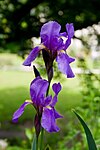
|
Croatian iris (Iris croatica) The Croatian iris (Croatian: perunika) is a beardedrhizomatousspecies ofiriswith branched stems and dark violet flowers that is endemic to temperate parts of Central Croatia and neighbouringSlovenia.It is on the Croatian list of strictly protected plants,[43]and is unofficially known as the national flower.[44]Within Croatia, it is found in areas likeŽumberak MountainsandMedvednica.Its name in Croatian stems from that ofPerun,the god of thunder inSlavic mythology. |
| National tree | 
|
Pedunculate oak (Quercus robur) The pedunculate oak (Croatian:hrast lužnjak) is a species of flowering plant in thebeech and oak family.It is a large tree, native to lowland temperate regions ofEurasia.40,000 hectares of oak forests cover theSpačva basinin eastern Croatia[45]and the tree is widely present in nationaltoponymy,as well as the lyrics to the national anthem where it represents strength and resilience. Additionally, the pedunculate oak branch was featured on the reverse side of the 5lipacoin.[46] |

|
Olive (Olea europaea) The olive (Croatian:maslina) is a species of plant in theolive family.It is a small tree or a shrub that is native to theMediterranean basin.Olive groves are widely cultivated in coastal parts and on islands of Croatia where they are used in the production of qualityolive oil.A 1,600-year-old olive tree in theBrijuni National Park[47]that still gives annual fruit is the oldest one in Croatia. Additionally, the olive branch was featured on the reverse side of the 20 lipa coin.[48] | |
| National dog breed | 
|
Dalmatian dog
The Dalmatian (Croatian:dalmatinacordalmatiner) is abreed of dogwith a white coat marked with dark-coloured spots. Originally bred as ahunting dog,[49]it was also used as acarriage dogin its early days, while today it is a popular pet. The origins of this breed can be traced back to present-day Croatia and its region of Dalmatia, from which it bears its name.[50]Other Croatian dog breeds include theTornjak,Posavac Hound,and theCroatian Sheepdog,among others. |
References
[edit]- ^abcdCroatian Parliament."Obilježja državnosti"(in Croatian).Retrieved5 April2024.
- ^Hercigonja 1984: 34.
- ^"Pleter Cross Description".croatiagifts.com.RetrievedAugust 3,2021.
- ^"Pravilnik Reda hrvatskog pletera"(in Croatian).Retrieved5 April2024.
- ^"GRBOVI I DRESOVI EURA: Kako je šahovnica postala simbol Hrvatske".Archived fromthe originalon 23 July 2017.
- ^"Designs of Croatian national sides of euro and cent coins presented".4 February 2022.Retrieved10 October2023.
- ^"Necktie evolution".Tie-a-Tie.net.Retrieved5 April2024.
- ^OCTOBER – THE CRAVAT DAY!ArchivedJuly 30, 2013, at theWayback Machine.Academia-cravatica.hr (October 18, 2003).
- ^"UNESCO - Lacemaking in Croatia".
- ^English, M."Croatian gingerbread is UNESCO cultural treasure".The Times Herald. Archived fromthe originalon 28 July 2021.Retrieved5 April2024.
- ^Hrvatski foklor: Narodne nošnjeArchived2010-01-25 at theWayback Machine(in Croatian)
- ^Marković, Ivan (1898)."Giornale del blocco ed assedio della fortezza di Sign".Sinj i njegovo slavlje | god. 1887 | spomen knjiga sa 11 slika(in Croatian). Dionička tiskara u Zagrebu.
- ^"UNESCO - Sinjska Alka, a knights' tournament in Sinj".Archivedfrom the original on 2020-12-08.Retrieved2021-02-15.
- ^"The Tamburitza and the preservation of Croatian folk music".Croatianhistory.net.Retrieved20 April2021.
- ^"History of Varaždin".Retrieved5 April2024.
- ^"5 kuna"(in Croatian).Retrieved5 April2024.
- ^Kristina Džin 2009: 7.
- ^"10 kuna"(in Croatian).Retrieved5 April2024.
- ^"Obnovljeni dvorac Eltz vraća stare vizure Vukovara".Glas Slavonije(in Croatian). 29 October 2011. Archived fromthe originalon 6 April 2012.Retrieved5 April2024.
- ^"20 kuna"(in Croatian).Retrieved5 April2024.
- ^"Old City of Dubrovnik".UNESCO World Heritage Centre.United Nations Educational, Scientific, and Cultural Organization.Retrieved5 April2024.
- ^"50 kuna"(in Croatian).Retrieved5 April2024.
- ^"100 kuna"(in Croatian).Retrieved5 April2024.
- ^"200 kuna"(in Croatian).Retrieved5 April2024.
- ^Fik Meijer (2004)Emperors Don't Die in Bedp. 114.
- ^"500 kuna"(in Croatian).Retrieved5 April2024.
- ^Register of Cultural Goods of Croatia."Izvod iz registra kulturnih dobara Republike Hrvatske br. 01/10 - Lista preventivno zaštićenih dobara"[Excerpt from the register of cultural goods of the Republic of Croatia No. 01/10, List of preventively protected goods].Narodne novine(in Croatian).Ministry of Culture (Croatia).
- ^"1000 kuna"(in Croatian).Retrieved5 April2024.
- ^"Zakon o vinu"[Wine Act] (in Croatian).Narodne novine.10 June 2003.Retrieved5 April2024.
- ^"Origin".Absolute Croatia.Retrieved5 April2024.
- ^Mostov, Julie;Iveković, Rada (2004).From Gender to Nation.Italy: Zubaan. pp. 65–79.ISBN9788186706688.
- ^Krešić, Mijo (5 December 1962)."Varaždin".Naše Gore List.II(34): 269.Retrieved5 April2024.
- ^Bousfield, Jonathan (2003).Croatia.Rough Guides. p. 72.ISBN1843530848.Retrieved5 April2024.
- ^Požeško-slavonska županija."O županiji"(in Croatian).Retrieved5 April2024.
- ^Virovitičko-podravska županija."Heraldika"(in Croatian).Retrieved5 April2024.
- ^Osječko-baranjska županija."Znamenja"(in Croatian).Retrieved5 April2024.
- ^"Eurokovanice"(in Croatian).Retrieved5 April2024.
- ^"Popis poljoprivrede 2020"(PDF)(in Croatian). Ministarstvo poljoprivrede. 2020.Retrieved2023-02-18.
- ^"2 kuna"(in Croatian).Retrieved5 April2024.
- ^British Library Sound Archive.British wildlife recordings: Nightingale,accessed 29 May 2013
- ^Maxwell, Catherine."The Female Sublime from Milton to Swinburne: Bearing Blindness",Manchester University Press, 2001, pp. 26–29ISBN0719057523
- ^"1 kuna"(in Croatian).Retrieved5 April2024.
- ^Ministry of Culture (Croatia)(2004-07-20)."Pravilnik o skupljanju samoniklih biljaka u svrhu prerade, trgovine i drugog prometa".Narodne novine(in Croatian) (4/100).Retrieved5 April2024.
- ^James MinahanThe Complete Guide to National Symbols and Emblems (2 Volumes),p. 364, atGoogle Books
- ^Vuletić, Dijana."Ecological and climate changes and regeneration related issues of pedunculate oak forests in Spačva basin".Croatian Forest Research Institute.Retrieved5 April2024.
- ^"5 lipa"(in Croatian).Retrieved5 April2024.
- ^"Ancient Olive Tree".Brijuni National Park.Archivedfrom the original on 25 May 2016.Retrieved27 May2016.
- ^"20 lipa"(in Croatian).Retrieved5 April2024.
- ^Milivoje Urošević; (2018)Basic morphometric parameters of the Dalmatian dog (Canis dalmaticus)p. 187; {Međunarodne kinološke federacije (FCI, 2017.) koja ovu pasminu svrstava u šestu grupu, grupu goniča..International Kennel Federation (FCI, 2017) classifies this breed in the sixth group, the group of hunting dogs.}[1]
- ^"Dalmatian | Characteristics, Temperament, & Facts | Britannica".www.britannica.com.2023-05-24.Retrieved2023-06-24.


